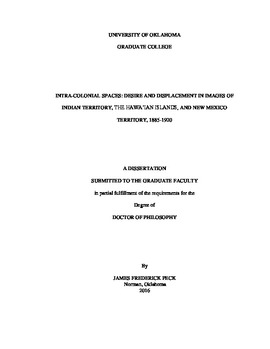| dc.description.abstract | Depending primarily on image analysis, this dissertation considers a heretofore understudied artistic construct, the American intra-colonial aesthetic. Produced as a byproduct of displaced American colonialist desires near the turn of the twentieth century, the visual practices used to achieve this aesthetic were flexible and multivalent, and included the use of visual erasure or displacement of indigenous peoples; the use of Euro-American visual surrogates, or placeholders who visually appropriate the land; the depiction of indigenous peoples as existing only in the ethnographic present; and the appropriation of natural resources into a non-indigenous epistemology. In addition, indexicality, a meta-narrative element that suggests the limits of ideology in art-making, is examined.
This analysis locates the American intra-colonial aesthetic through three different cases studies of marginalized contact zones within the burgeoning American empire, circa 1885-1920 – Indian Territory, the Hawaiian Islands, and New Mexico Territory. While each chapter makes a different argument about the nature, scope, and characteristics of the intra-colonial aesthetic, the arguments are highly inter-related and depend upon, and strengthen, one another. Methodologically, I privilege images as primary historical documents, foregrounding my belief that art remain the first and best evidence for the art historian. Finally, I apply Edward Said’s concept of the Orient, and its inverse, the Occident, as theoretical constructions. As such, images and texts made by Euro-Americans concerned with colonial desire are counterbalanced by images and texts made by indigenous peoples concerned with native survival and sovereignty. | en_US |

